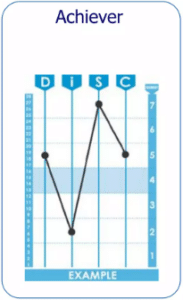If you’ve taken a DiSC® Classic 2.0 or DiSC Classic paper version of the DiSC assessment, you may have had a style that doesn’t seem to appear in Everything DiSC® reports. Why?
The answer relates to how your DiSC style is represented in the Everything DiSC map, or circle. It uses a circumplex model and a dot to represent your style. The older and less accurate DiSC Classic model plotted your assessment results on a graph.
 One of the most common questions about the transition from using patterns from DiSC Classic to using the DiSC circle involves the Achiever (DS or SD style) and Appraiser (iC or Ci style) patterns. These patterns describe people who are high in two DiSC styles that are theoretically opposite each other.
One of the most common questions about the transition from using patterns from DiSC Classic to using the DiSC circle involves the Achiever (DS or SD style) and Appraiser (iC or Ci style) patterns. These patterns describe people who are high in two DiSC styles that are theoretically opposite each other.
There are people who have taken the DiSC Classic assessment multiple times throughout the years and repeatedly receive one of these opposite-style patterns. So what happens when they take the Everything DiSC assessment?
The Everything DiSC map
 Let’s look at the circumplex model and the location of the dot. The dot’s location tells you two things. In the image at right, it shows that the person almost straddles the C and D styles. They are a CD style. The dot’s placement toward the edge of the circle shows that this is a strong priority or preference. A dot positioned closer to the center of the circle would have indicated only a slight inclination toward the C and D styles.
Let’s look at the circumplex model and the location of the dot. The dot’s location tells you two things. In the image at right, it shows that the person almost straddles the C and D styles. They are a CD style. The dot’s placement toward the edge of the circle shows that this is a strong priority or preference. A dot positioned closer to the center of the circle would have indicated only a slight inclination toward the C and D styles.
Note the shading around the dot. It reflects that this person has a bit of i and S as well. On a graphed report, we’d see that the scores for C and D were high, while the i and S scores were low.
You’ll notice that there are words surrounding the circle that aren’t present in the DiSC Classic graph report. That’s because Everything DiSC also measures priorities. In the image above from an Everything DiSC Productive Conflict profile, you’ll see that this person prioritizes control, justification, and objectivity when in conflict. They might offer or seek reassurance during a conflict, but it won’t be their go-to response.
 It’s possible for someone to have four or even five priorities. Their circles look a little different. The person with the example at right might have been an Appraiser in the older DiSC Classic. This example is of an i-style persona who prioritizes action, enthusiasm, collaboration, and accuracy. Accuracy isn’t characteristic of most people with the i style. It will be much easier, or take less energy, for this person to focus on details or double-check their work than it will be for most others with the i style.
It’s possible for someone to have four or even five priorities. Their circles look a little different. The person with the example at right might have been an Appraiser in the older DiSC Classic. This example is of an i-style persona who prioritizes action, enthusiasm, collaboration, and accuracy. Accuracy isn’t characteristic of most people with the i style. It will be much easier, or take less energy, for this person to focus on details or double-check their work than it will be for most others with the i style.
When people who formerly got the Achiever or Appraiser patterns are plotted on the Everything DiSC circle, they usually have a dot that is quite close to the center of the circle. In fact, of all the patterns, these individuals have, by far, the shortest average distance from the center of the circle.
Like all models, DiSC is not a perfect representation of human nature. Some people are simultaneously very outgoing and enthusiastic while also being highly attentive to accuracy. Some people are very direct and blunt in their language while also being relatively empathetic. For this reason, the extra priorities within Everything DiSC provide additional insight into a person’s personality.
Facilitators or coaches working with someone with a fourth or fifth priority might want to use the Supplement for Facilitators report. It provides a bit more information on how the dot was placed and what responses to the assessment were unexpected.
Some assessments based on the DISC model still use graphs and will show the Appraiser and Achiever types. They are also sometimes called the opposite styles. We don’t recommend these assessments since they are quite a bit less reliable and precise than the Everything DiSC assessment.

